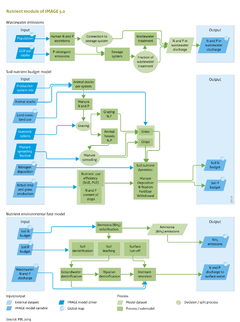Nutrients/Policy issues: Difference between revisions
Jump to navigation
Jump to search
No edit summary |
No edit summary |
||
| Line 1: | Line 1: | ||
{{ComponentPolicyIssueTemplate | {{ComponentPolicyIssueTemplate | ||
|Description=Under the baseline scenario of the [[Roads from Rio+20 (2012)|Rio+20 study]], N surpluses increase by 35% globally, which is the result of decreasing trends in North America, western Europe and Japan, and stabilisation in India; in all other regions, N surpluses increase (See figure below). This increase is particularly large in sub-Saharan Africa and Southeast Asia. For phosphorus we see a similar picture, with large increases in developing countries. | |Description=Under the baseline scenario of the [[Roads from Rio+20 (2012)|Rio+20 study]], N surpluses increase by 35% globally, which is the result of decreasing trends in North America, western Europe and Japan, and stabilisation in India; in all other regions, N surpluses increase (See figure below). This increase is particularly large in sub-Saharan Africa and Southeast Asia. For phosphorus we see a similar picture, with large increases in developing countries. | ||
Several different economic developments and policy interventions may modify individual terms in the soil nutrient budget ([[Equation 1]]), and the fate of nutrients in the environment. For example, agricultural demand affects: | |||
* the production of leguminous crops (pulses and soybeans) and biological N fixation as a consequence; | |||
* meat and milk production and thus animal manure production; | |||
* crop production and thus fertiliser use. | |||
}} | }} | ||
Revision as of 11:35, 8 January 2014
Parts of Nutrients/Policy issues
| Component is implemented in: |
| Components: |
| Related IMAGE components |
| Projects/Applications |
| Key publications |
